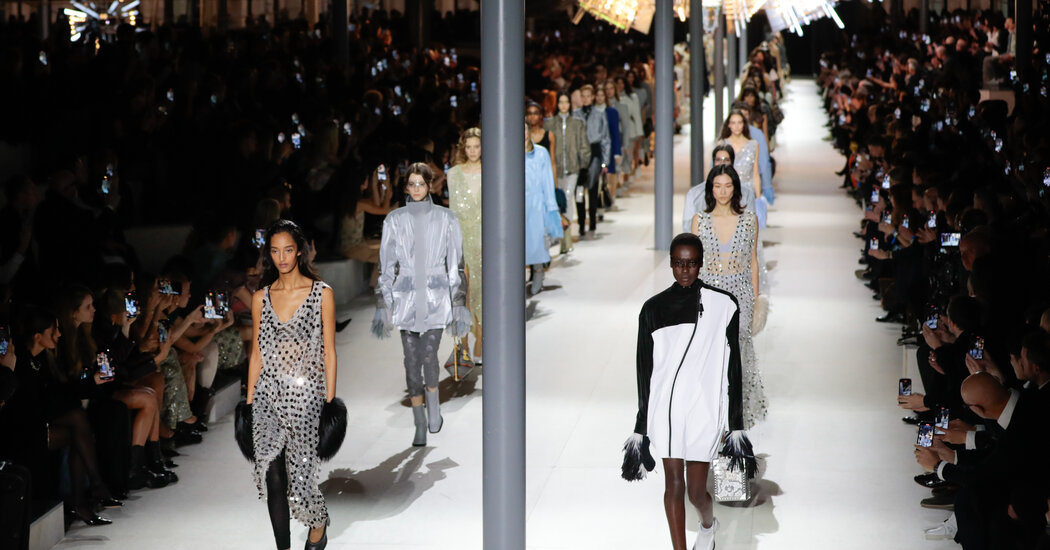One month, four cities, hundreds of shows. After all that, Nicolas Ghesquière of Louis Vuitton brought the curtain down on the fall season with a no-holds-barred 10th anniversary show — in front of 4,000 celebrities, guests and brand employees — that not only celebrated his decade at the house but the whole absurd, delightful enterprise known as fashion.
Imagine an enormous, bombastic set in the Louvre courtyard called the Cour Carrée, with a glowing orb created by the French artist Philippe Parreno at its center, sending out beams of light like an alien starship. Well, sometimes this industry and what it makes can seem like offerings from another planet: entirely removed from the substance of the everyday. But how else, really, to get imaginations sparking and capture the promise of alternate tomorrows?
Mr. Ghesquière did just that with a wild amalgamation of shapes and references that echoed collections he had made before without actually repeating them: techno traveler’s jackets dangling strands of pasta-shaped fringe from the sleeve; fragile fainting couch gowns covered in sparkling paillettes or glass beads and worn over ribbed workout-wear; crisp origami minidresses that looked like folded images of Louis Vuitton trunks; and on and on.
There were elaborately encrusted Louis XVI jackets paired with 1970s leather pants and skirts, cave man furs that were actually made of feathers and feathered evening looks that turned out to be silk.
In the end, that may be the biggest takeaway of the season. The — to be very B-school about it — most important learning. The one thing that should inform not just shopping but, more important, dressing. The thing everyone does every morning.
The point isn’t so much what exactly you wear, but how you wear it: with commitment and a touch of formality. That’s what you need for next season. Not one specific item, not a mood or a vibe, but an attitude. This is, after all, no longer a time for half measures; that way lies disaster. It is a time to stand for something. Pay attention to details. Dress to meet the moment, even when the moment is a mess. Maybe especially when it is a mess.
It’s a gesture of respect for yourself and those around you. The momentum has been building since the world emerged from pandemic isolation, cycling out of comfort clothing into confusion, tugged toward the allure of the recent FX series about Capote’s “Swans,” and the erstwhile rituals of dress. Remembering what it means to construct the public self.
As Pierpaolo Piccioli said before an all-black Valentino show that had a whiff of the 1940s in its strong shoulders, elegant shirtwaists and lace skirts that swirled around the body like mist, it is only when “we are aware of the darkness that we can look for the light.” Awareness being key.
There was no single dominant garment that proved the through-line among cities. Instead there was a slow amalgamation of micro-trends. A lot of high boots, because, yeah, walk this way. At Chanel, Virginie Viard did a great pair — platform, suede — in her best show yet, full of swishy, long-line bouclé coats and floaty seaside dresses, and dedicated to the demoiselles of Deauville, the resort where Coco spent her early years as a designer.
What else? Drop-crotch pants were big (no pun intended), the newest version of the now ubiquitous oversize trou, masterfully made at Schiaparelli where Daniel Roseberry tamped down the surrealism and focused on the smarts to great effect. Victoria Beckham called her version the “elevator trouser,” because it was high (waisted) and low (crotched), with a flare at the end, creating an extra long line.
Also dramatic trenches, as at Balmain, where Olivier Rousteing even swirled them into midcentury gowns, and the Row, where Mary-Kate and Ashley Olsen offered a fabulous trapeze-line version that had the volume and glamour of “Casablanca” couture (and then topped many looks with some character headgear). A lot of leopard print.
Miuccia Prada summed it up, as she often does, after a Miu Miu show that swerved away from abbreviated set dressing in favor of ladylike clichés — pencil skirt suits, the little black dress, grandma furs, pearls, brooches, gloves, even what looked like nurse’s uniforms — as if seen through Lewis Carroll’s looking glass and in a bouquet of Crayola shades. Shorn of nostalgia for the past, remixed for the future. The furs were thrown over jeans, the little skirt suits worn with leather spa slides, like a fantasy vacation souvenir.
The point, she said, is for each person to decide whom they want to be. The variables are there. You just have to pull yourself — and your outfits — together. Level up.







